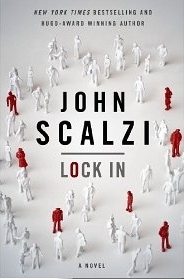 Format read:
Format read: ebook provided by Edelweiss
Formats available: ebook, hardcover, audiobook
Genre: Science fiction
Length: 337 pages
Publisher: Tor Books
Date Released: August 26, 2014
Purchasing Info: Author’s Website,
Publisher’s Website,
Goodreads,
Amazon,
Barnes & Noble,
Kobo,
Book Depository
Not too long from today, a new, highly contagious virus makes its way across the globe. Most who get sick experience nothing worse than flu, fever and headaches. But for the unlucky one percent – and nearly five million souls in the United States alone – the disease causes “Lock In”: Victims fully awake and aware, but unable to move or respond to stimulus. The disease affects young, old, rich, poor, people of every color and creed. The world changes to meet the challenge.
A quarter of a century later, in a world shaped by what’s now known as “Haden’s syndrome,” rookie FBI agent Chris Shane is paired with veteran agent Leslie Vann. The two of them are assigned what appears to be a Haden-related murder at the Watergate Hotel, with a suspect who is an “integrator” – someone who can let the locked in borrow their bodies for a time. If the Integrator was carrying a Haden client, then naming the suspect for the murder becomes that much more complicated.
But “complicated” doesn’t begin to describe it. As Shane and Vann began to unravel the threads of the murder, it becomes clear that the real mystery – and the real crime – is bigger than anyone could have imagined. The world of the locked in is changing, and with the change comes opportunities that the ambitious will seize at any cost. The investigation that began as a murder case takes Shane and Vann from the halls of corporate power to the virtual spaces of the locked in, and to the very heart of an emerging, surprising new human culture. It’s nothing you could have expected.
At the publisher’s request, this title is being sold without Digital Rights Management software (DRM) applied.
My Review:
The summary from Goodreads above should have been the summary for the prequel, Unlocked (reviewed here). Reading Unlocked first truly immerses the reader into the world of Lock In.
But Lock In isn’t so much about how Haden’s developed or the way that the treatment unfolds, it’s much more a story about the way that the world has changed in the years since Haden’s exploded, and how humans, in their myriad ways, manage to adapt, explore and exploit this brave new world.
At heart, it felt to me as if Lock In was a detective story, almost a police procedural, complete with the traditional buddy relationship between the new FBI partners. The difference is that all the crimes involved deal with Haden survivors, and the crime itself could only take place among, with, by and to the Haden community.
Rookie FBI agent Chris Shane is a Haden. He contracted Haden’s as a child, and became literally the poster child for the disease. But now it is 20 years later and the world has adapted, and so have the Hadens. His brain may not be communicating much with his body (the condition known as “lock in”) but technology along with a lot of research dollars have created a way for Hadens to communicate and interact with the outside world.
Chris uses a “threep”, and it is named for that beloved robot from Star Wars, C3-PO, because that’s what it looks like. With a threep, a Haden can go to work, travel, talk, and do anything that anyone else can do. Even better, since they can use any threep made available to them, a talent which Chris uses as the case evolves from a relatively simple looking murder in Washington D.C. to a cover-up in the Four Corners of the Navajo Nation.
His veteran partner Leslie Vann is also part of the Haden community, but a very distinct part. A relatively small number of the people who contracted Hadens survived with their body and brain connection intact, but with a critical difference; their brains were altered enough by the disease to allow them to become Integrators, people who let “locked in” Hadens piggyback into their brains and use their bodies for a while. Although Vann trained as an Integrator, the experience scarred her in ways that she still can’t handle well.
But she does know the Haden community, so she and Shane investigate crimes that involve that community.
At first, the crime seems relatively straightforward; a man is dead and another man is found at the crime scene covered in the victim’s blood. And the local cops hate the FBI agents, but that’s nothing new.
Into the mix we add elements that move it from simple crime to extraordinary discovery; the supposed perpetrator was an Integrator who was acting for a client. The definite victim was secretly implanted with the neural net to make him an integrator, an illegal and highly dangerous practice.
And somewhere in the mix, we have the government shutdown and withdrawal from all Haden’s research, along with the greed and scrambling that is inevitable when the government pulls the plug on a massive-scale program.
There’s more than enough billions involved for lots of people to invent new ways to commit murder.
Escape Rating A+: I’ll say upfront that there seem to be two schools of thought about Lock In–that it’s marvelous if you’ve read Unlocked, and that it doesn’t make a lot of sense if you haven’t. Since I read Unlocked, I’m not sure about the second camp. Read Unlocked.
 Lock In starts with Shane being assigned to the first case in the chain of events. The story is from his perspective, both as a new FBI agent and as a Haden operating a threep. The post-Hadens world is the only life that Shane remembers, he was too young to remember much of “before”. For him, this is the way life IS. As we don’t explain to ourselves the entire history of computers every time we hit the power switch, Shane doesn’t brood over the history of Haden’s or Haden’s research; he just lives with the result.
Lock In starts with Shane being assigned to the first case in the chain of events. The story is from his perspective, both as a new FBI agent and as a Haden operating a threep. The post-Hadens world is the only life that Shane remembers, he was too young to remember much of “before”. For him, this is the way life IS. As we don’t explain to ourselves the entire history of computers every time we hit the power switch, Shane doesn’t brood over the history of Haden’s or Haden’s research; he just lives with the result.
Chris makes an excellent point-of-view character, as the new detective often is in a certain kind of mystery. The procedures are new to him, so they do require a certain amount of natural explanation. We get to see what is different in this futuristic mystery, and what is the same.
Internecine warfare between competing investigating agencies, along with the negotiation of rights and responsibilities (and blame) between the Metro Police, the FBI and that Navajo Nation police are not just familiar, but they ground the story in relatable patterns. The corporate greed and corruption that turns out to be at the heart of the case is something that we are all more than familiar with.
What’s different here are the means and opportunity. The world that Haden’s has created has added whole new ways of committing murder. Almost unthinkable means. But the story works because we are all too aware that human motives haven’t changed one damn bit.
Chris makes us see both the continued humanity of Hadens, and the crime makes us aware that even adapted people can be all too human in their very inhumanity.
***FTC Disclaimer: Most books reviewed on this site have been provided free of charge by the publisher, author or publicist. Some books we have purchased with our own money or borrowed from a public library and will be noted as such. Any links to places to purchase books are provided as a convenience, and do not serve as an endorsement by this blog. All reviews are the true and honest opinion of the blogger reviewing the book. The method of acquiring the book does not have a bearing on the content of the review.












